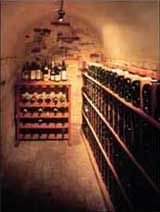
Smack in the middle of the basement of the Milton house, the This Old House crew found an unused room filled with cobwebs and empty shelves. More than 8 feet deep and 5 feet wide, with a barrel-vaulted ceiling supporting the house’s massive central chimney above, the space had potential. It was cool, dark and compact—the perfect climate for a wine cellar. With that in mind, the crew got to work transforming a forgotten store room into a rustic wine cellar with atmosphere to spare.
Before the crew could start building the cellar, they first had to rid the basement of persistent dampness. They installed a duct system to remove moist air and introduce fresh, dry air and a sump pump in case the already-high water table rose. To fight future dampness, they used exterior-grade materials like pressure-treated lumber, foam insulation board, galvanized mesh lath and rot-resistant cedar.
The next task was tackling the graceful chamber’s only flaw—a rectangular doorway that obscured the vaulted space inside. The fix? An arched entry to echo the lines of the ceiling. First, the crew knocked out some of the brick surrounding the current door. Then, they placed a plywood form shaped like the barrel vault in the opening and filled in around it with bricks and mortar. The cellar now had a graceful archway.
Within the archway, the crew built a wall to frame the door, leaving the curved edge of the bricks visible. The new wall was insulated with polystyrene board, caulked at the edges, covered with galvanized-wire lath screwed into the studs, and finished with two coats of plaster. While the plaster dried, they went back to the shop to build the door, a slab of 3/4″ rigid insulation sandwiched between two cedar panels. Weatherstripped and set into an arched frame, the door echoed the curve of the archway and provided an elegant, air-tight entrance to the cellar. A double paned window of tempered glass allowed owners a glimpse of their maturing collection.
While the cellar’s basement location gave it a head start, it would still need a special cooling unit to protect the wines’ delicate chemistry. Wine loves a steady environment: warmth can destroy flavor and accelerate aging, and fluctuating humidity levels can set corks popping. The cooling unit (similar to an air conditioner), tucked in the room’s lower right hand corner, provided the ideal environment for wine—a temperature between 50 and 60 degrees Fahrenheit and a humidity level between 60 and 70 percent. Cellars are often insulated and lined with redwood or cedar paneling but this room was left bare to show off the rugged brick and stone walls. In addition to incandescent lights, two strips of tiny halogens lined the room where the walls met the arch, providing dramatic uplighting.
Finally, the cellar was ready for its custom-built cedar racks. Nearly seven feet long, one foot deep, and four feet high, they hugged the right wall and rested on a cedar platform scribed and trimmed to fit the uneven floor. Racks keep bottles horizontal, their corks wet, and allow any sediments to settle. A small cedar table was placed at the end of the room, ready for in-cellar tastings. Soon 216 bottles of wine found their resting place—a cool, dark cellar where they could age gracefully.
